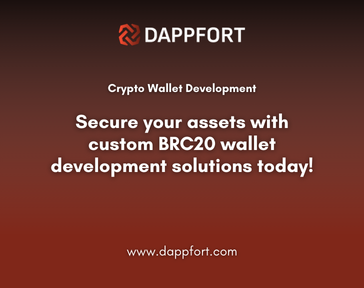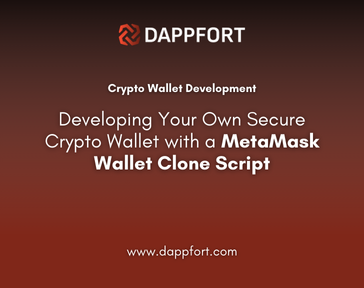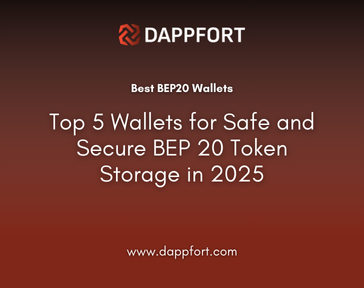
Table of Contents
Are you tired of high transaction fees and slow transfers? If you’re using USDT, there’s a better way to store and transfer your crypto. USDT TRC20 wallets are the game-changer you’ve been looking for!
Whether you’re a seasoned trader or a newcomer to the crypto world, managing your USDT with a reliable wallet is essential for maximizing security, minimizing fees, and ensuring fast transactions.
In this comprehensive guide, we’ll walk you through everything you need about USDT TRC20 Wallets. From understanding what a USDT TRC20 Wallet is, how it works, and its key features, to the benefits it offers over other wallet types, this article will help you decide how to manage your USDT tokens securely and efficiently. Additionally, we’ll discuss the cost of developing a USDT TRC20 Wallet and how to create a USDT TRC20 Wallet.
Read on to discover why a USDT TRC20 Wallet could be the best choice for your crypto assets!
What is the USDT TRC20 Wallet?
A “USDT TRC20 wallet” consists of three main parts: USDT, TRC20, and wallet. USDT, or Tether, is a stablecoin cryptocurrency pegged to the US Dollar. Launched in 2014, it aims to solve the volatility issues of most cryptocurrencies, maintaining a 1:1 peg with the USD (1 USDT = 1 USD).
Tether operates on multiple blockchain networks like Ethereum, Bitcoin, and Tron. TRC20 is the token standard on the Tron blockchain, enabling the issuance of USDT on this network. Therefore, USDT TRC20 refers to Tether issued using the TRC20 standard.
A USDT TRC20 Wallet is a digital wallet designed specifically for managing and storing TRC20 USDT tokens. These wallets allow users to send, receive, and store USDT on the Tron network, offering benefits such as lower transaction fees and faster transaction speeds compared to other networks like Ethereum.
Key Variants of USDT TRC20 Wallets You Should Know
Since USDT operates on multiple blockchains, the type of wallet you select depends on the specific blockchain it supports. As previously mentioned, common types include Tether ERC20 on the Ethereum blockchain and USDT TRC20 on the TRON blockchain. You can store USDT TRC20 tokens in various types of wallets, both hot and cold. Below are the primary types of USDT TRC20 wallets:
- Desktop Wallets
- Mobile wallets
- Online Wallets
- Hardware Wallets
- Paper Wallets
Each wallet type comes with its own pros and cons, and the right choice depends on your security needs, convenience preferences, and how frequently you intend to access your USDT TRC20 tokens.

🚀 Ready to Start Your USDT TRC20 Wallet Development?
Let’s build a secure and fast wallet for seamless transactions today! 💼🔐
Understanding TRC20 Wallet: A Quick Overview
TRC20 stands for TRON Request for Comment 20, a token standard on the TRON blockchain. Similar to Ethereum’s ERC20 standard (Ethereum Request for Comment 20), TRC20 outlines rules that ensure crypto tokens can operate seamlessly across various platforms and wallets.
A TRC20 token, like USDT, adheres to these rules, making it compatible with TRC20-supported wallets and platforms. In simpler terms, USDT issued as a TRC20 token can be shared, swapped, and stored across supported wallets, just like any other crypto token.
A digital wallet is software that securely stores the private keys needed to manage your crypto holdings on the blockchain.
A USDT TRC20 wallet specifically stores keys for USDT tokens on the TRON blockchain network, making it a crucial tool for anyone looking to manage or transact in USDT on the TRON network.
As blockchain technology continues to evolve, businesses are increasingly integrating USDT TRC20 wallet functionality into their platforms, enabling smooth cryptocurrency transactions for users in e-commerce, financial services, and other sectors.
Top Benefits of USDT TRC20 Wallet App Development
A USDT TRC20 wallet, designed specifically for storing Tether (USDT) tokens on the Tron blockchain as TRC20 tokens, brings numerous advantages to users. Here are some of the key benefits:
Fast and Affordable Transactions
TRC20-based USDT transactions on the Tron blockchain offer exceptionally fast speeds and minimal transaction fees when compared to other networks, like Ethereum’s ERC-20. This makes it a more cost-effective and efficient choice for sending and receiving USDT.
Cross-Platform Accessibility
USDT TRC20 wallet apps are available across different platforms, including web wallets, desktop applications, and mobile wallets. This ensures that users can access and manage their USDT tokens easily on any device, whether at home or on the go.
High Compatibility
USDT TRC20 tokens are highly compatible with a wide array of decentralized applications (DApps) built on the Tron network. This enables users to engage in various DeFi services, games, and other blockchain-based activities without issues.
Secure Storage Features
Security is a priority for USDT TRC20 wallets. Features like data encryption, PIN codes, biometric authentication, and backup options work together to protect the user’s assets from potential threats.
Intuitive and Easy-to-Use Interface
Most USDT TRC20 wallet apps provide a clean, user-friendly interface, designed to make it simple for both novices and experienced users to manage their USDT tokens without hassle.
Transaction Transparency
The Tron blockchain offers transparent transaction history, so users can easily track and verify their transactions, ensuring that they have full visibility of their fund movements and balances.
Reduced Network Congestion
The Tron network’s high capacity and low transaction fees make it a solid choice for USDT TRC20 transactions, especially for frequent transfers. It’s a more efficient alternative compared to other blockchains that may experience congestion and higher costs.
In summary, a USDT TRC20 wallet enables users to enjoy fast, secure, and cost-effective USDT transactions on the Tron blockchain. With excellent compatibility with DApps and other blockchain features, these wallets provide a complete solution for users managing USDT tokens in a secure, efficient manner.
Salient Features of USDT TRC20 Wallet
A USDT TRC20 Wallet typically comes equipped with a variety of features that elevate the user experience while providing specific functionalities tailored to the Tron blockchain ecosystem. Below are some of the standout features that the top TRC20 wallet development companies incorporate into their wallet solutions:
USDT TRC20 Token Support
The primary feature of a USDT TRC20 wallet is its compatibility with USDT tokens on the Tron blockchain, specifically in the TRC20 format. This ensures that users can store, send, and receive USDT seamlessly.
Fast and Low-Cost Transactions
USDT TRC20 transactions on the Tron network are well known for their speed and low transaction fees. This makes it a cost-effective choice for transferring USDT tokens compared to other blockchains, such as Ethereum.
Cross-Platform Compatibility
USDT TRC20 wallets are designed to work across multiple platforms, including web wallets, desktop applications, and mobile wallets. This compatibility ensures users can manage their USDT tokens on various devices and operating systems.
Robust Security Features
Security is a top priority, and USDT TRC20 wallets come equipped with a wide range of security measures, such as data encryption, PIN codes, biometric authentication, and secure backup options, all of which help protect the user’s assets.
Transparent Transaction History
Users have access to a transparent transaction history on the Tron blockchain, providing them with the ability to easily verify and track their transactions, ensuring full transparency of their funds.
Multi-Language Support
To cater to a global audience, many USDT TRC20 wallets offer multi-language support, allowing users from different regions to navigate and use the wallet in their preferred language.
Cross-Chain Swap Functionality
Some wallets offer cross-chain swap features, allowing users to exchange USDT tokens for other cryptocurrencies without leaving the wallet. This adds flexibility and convenience for users engaging with multiple tokens.
Backup and Recovery Options
To safeguard against potential loss, USDT TRC20 wallets provide backup and recovery options. This ensures that users can recover their funds in the event of device failure or accidental loss of private keys.
Transaction Notifications
Users receive real-time notifications about their USDT transactions and wallet activities. This helps them stay up-to-date with their holdings and provides greater control over their wallet’s operations.
These features combine to deliver a secure, efficient, and versatile environment for users managing their USDT assets in the TRC20 wallet app. By leveraging the benefits of the Tron network, such as low fees and fast transactions, users can benefit from decentralized wallet security and full control over their digital assets.

🛠️ Unlock the Power of USDT TRC20 Wallet Development!
Secure, fast, and affordable crypto transactions await you! Start now! 🌟💰
Top 5 USDT TRC20 Wallets in 2025
Choosing the right wallet can be overwhelming. To make it easier, we’ve compiled a list of the top USDT TRC20 wallets that stand out in terms of security, usability, and features.
| Wallet Name | Platform | Security Features | Best For | Rating |
| Exodus Wallet | Desktop/Mobile | 2FA, Private Keys | Beginners & Experienced | ★★★★☆ |
| Trust Wallet | Mobile | Fingerprint, PIN | Mobile-focused Users | ★★★★☆ |
| Ledger Nano X | Hardware | Hardware, 2FA | Advanced Users, Investors | ★★★★★ |
| TronLink Wallet | Desktop/Mobile | Private Keys | Tron Ecosystem Users | ★★★★☆ |
| MetaMask | Desktop/Mobile | 2FA, Encryption | ERC-TRC20 Users | ★★★☆☆ |
These wallets offer various features suited for different types of users. Whether you’re just starting or an advanced crypto investor, you can find a wallet that fits your needs.
How to Develop a USDT TRC20 Wallet: An In-Depth Step-by-Step Guide
The USDT TRC20 wallet development process is multi-stage, requiring meticulous attention to detail and a solid understanding of blockchain technology. Here is a breakdown of the major steps in building a USDT TRC20 wallet.
Step 1: Conceptualization and Planning
The first step of a USDT TRC20 wallet development process is to understand your business goals and specific wallet requirements. This stage focuses on identifying the wallet’s purpose, audience, and functionality.
Key decisions to make at this point include:
- Will the wallet serve individuals or businesses?
- Will the wallet support only USDT (TRC20) or multiple cryptocurrencies?
You should also analyze market trends and identify user needs while planning. It’s important to create a roadmap, outlining milestones and steps to ensure the wallet aligns with your long-term vision.
Step 2: Design and Prototyping
Once you have a clear understanding of the wallet’s purpose, the next step is to visualize your ideas. Prototyping allows you to refine your concept and determine how it will appeal to your target audience.
At this stage, create wireframes and prototypes. Prioritize user-friendly interfaces by focusing on core UX principles like consistency, simplicity, and accessibility. Ensure that important features like transaction history, notifications, coin transfers, and authentication are easily accessible.
Step 3: Core Development Processes
Now, things start to get more technical.
After finalizing the visual design, it’s time to bring those concepts to life by converting them into functional code. The goal at this stage is to build a robust, scalable backend for the USDT TRC20 wallet that can handle the growing demands of its users. Achieving this can be challenging, but it’s essential for creating a high-performance wallet.
Key development processes at this stage include:
Key Generation and Management Implementation
The security of user funds depends on effective key management, which is critical for the smooth functioning of your wallet.
Key generation and management refer to the processes of creating, distributing, storing, and securely handling cryptographic keys throughout their lifecycle. These keys, used in algorithms, allow users to access and control their digital assets.
This step involves implementing cryptographic algorithms to generate keys, secure backup storage, and solutions to protect the keys over time.
Smart Contract Development
Smart contracts are an essential part of any crypto wallet. They manage the tokens on the blockchain and are often written in the Solidity programming language.
Strict adherence to TRC20 standards is crucial to ensure smooth functionality. Thorough testing of smart contracts guarantees that the wallet operates reliably and performs without issues.
Transaction Handling Features
Transaction handling involves signing and broadcasting transactions.
These features enable users to transfer crypto tokens between wallets. They work in conjunction with key generation and management to ensure that users can securely access their wallets.
For example, transaction signing uses private keys to verify a user’s identity, while transaction broadcasting ensures that all transactions are accurately validated and broadcast to the blockchain.
Security Features Implementation
Robust security is essential to protect both the platform and its users, safeguarding against potential vulnerabilities and boosting trust in the platform.
Key security features to implement include:
- Multisignature Support: Requiring multiple private keys before executing a transaction, reduces the risk of hacking.
- Secure Password Management: Protecting user passwords and passphrases to ensure safe access to funds.
- Two-Factor Authentication (2FA): Adding an extra layer of security by requiring users to verify their identity in two ways.
- Cold Storage: Storing private keys offline to protect against platform-wide hacks.
- Biometric Authentication: Enabling users to access the wallet using biometric data like fingerprints or facial recognition.
- Real-Time Transaction Monitoring: Detecting unusual behavior by continuously tracking crypto assets.
Other functionalities might need to be integrated depending on the specific requirements of your USDT TRC20 wallet. This phase ensures that all the essential features are implemented and fully functional.
Step 4: Testing and Quality Assurance
Testing is essential to ensure that the wallet functions as expected in real-world scenarios. The goal is to deliver a high-quality, secure product that meets user expectations.
Tests to conduct include:
Unit Tests: Verify individual components of the USDT TRC20 wallet to ensure they work as intended.
Integration Tests: Ensure that all modules work together cohesively.
User Acceptance Testing (UAT): Let users interact with the wallet and gather feedback to improve functionality.
Security Audits: Conduct thorough security assessments to detect vulnerabilities.
System Tests: Ensure the wallet meets all technical specifications and is ready for public use.
Step 5: Deployment and Launch
Once you’ve ensured that all components of your USDT TRC20 wallet are working individually and cohesively without any security flaws, it’s time to prepare for a smooth and successful launch. This stage involves installing, configuring, and making the app available for release on public or enterprise app stores.
The deployment and launch process includes setting up cloud infrastructure, configuring servers, and transitioning the wallet into a live environment where users can access and use it seamlessly.
If you’ve carefully followed each step leading up to this point, the deployment and launch process should run smoothly. However, unforeseen challenges can arise during the development lifecycle, so it’s important to stay vigilant. Monitor the wallet’s performance and user interactions closely to quickly identify and address any issues that may surface post-launch.
Step 6: Ongoing Support and Updates
Even after the successful deployment and launch, continuous monitoring of the wallet’s performance in the market is crucial. Keep an eye on user adoption, feedback, and any emerging trends in the crypto space.
By doing so, you’ll gain valuable insights that can help you ensure your wallet remains secure, functional, and competitive in the ever-evolving crypto ecosystem.
Here are some key areas to focus on to keep your wallet relevant and operational:
- Performance Monitoring: Regularly track the wallet’s performance to ensure smooth operation and address any emerging issues promptly.
- User Feedback: Actively collect and analyze feedback from users to identify areas for improvement and better meet their needs.
- Maintenance and Support: Provide consistent maintenance and responsive support to ensure the wallet functions optimally.
- Security Updates: Stay on top of the latest security threats and implement timely updates to protect your wallet and users from potential vulnerabilities.
- Compliance and Regulation Updates: Keep your wallet in line with the latest legal and regulatory changes in the crypto space to ensure ongoing compliance.
By prioritizing these factors, you can keep your USDT TRC20 wallet secure, up-to-date, and ready for continued success in the market.

📈 Take Your USDT TRC20 Wallet Development to the Next Level!
Enhance security and speed for your crypto transactions. Let’s talk today! 🛡️🚀
How Much Does USDT TRC20 Wallet Development Cost?
The cost of developing a USDT TRC20 wallet varies based on several factors, as creating a secure and functional crypto wallet is a complex process. Hiring a professional blockchain development company is crucial for success. Here are the main factors affecting cost:
- Features and Complexity: Advanced features like multi-signature support, cross-chain transactions, and enhanced security protocols will increase the cost.
- Development Team: The cost can differ depending on whether you hire an in-house team or outsource to a development company, as hourly rates and expertise matter.
- Design and User Experience: A clean, intuitive UI/UX design is critical for adoption but may raise the overall cost.
- Testing and Security: Thorough testing and security audits add to the expense but are necessary for building user trust and ensuring wallet safety.
- Platform Compatibility: Developing for multiple platforms, such as web, mobile, and desktop, will raise costs.
For accurate cost estimates, it’s essential to provide detailed project requirements and consult a TRC20 wallet development company. Prioritizing security and smooth user experience is key.
Hire Our Expert Developers and Take Your USDT TRC20 Wallet to New Heights!
Dappfort, a leading crypto wallet development company, specializes in building secure and feature-rich USDT TRC20 wallets tailored to your business needs. Our expert developers ensure seamless TRON blockchain integration, lightning-fast transactions, and top-tier security for hassle-free USDT management.
With advanced encryption, multi-layer security, and user-friendly interfaces, our custom TRC20 wallet solutions empower businesses with safe and efficient crypto transactions.
✅ Seamless TRON Blockchain Integration
✅ Fast & Low-Cost USDT Transactions
✅ Multi-Layer Security & Encryption
✅ Cross-Platform Compatibility (Web & Mobile)
✅ Custom Features & Easy API Integration
Launch your secure USDT TRC20 wallet with Dappfort today! 🚀
Frequently Asked Questions About USDT TRC20 Wallet Development
How much does it cost to develop a TRC20 Wallet?
The cost of developing a TRC20 wallet varies according to the complexity of the features, development time, and security measures. The cost can range from $1,000 to $20,000, depending on your project’s specifications.
Which wallet is the best for storing USDT TRC20 tokens?
Top wallets for storing USDT TRC20 tokens include TronLink, Ledger, Atomic Wallet, and Trust Wallet. These wallets provide robust security, simple user interfaces, and smooth integration with TRC20 transactions, making them reliable options for holding your USDT.
How are transaction fees determined for USDT TRC20 wallets?
Transaction fees for USDT TRC20 wallets can vary depending on the platform. These fees could be a flat rate or a percentage of the transaction amount, and they are influenced by factors like network congestion, wallet providers, and the value being transferred.
Which software wallets support TRC20 tokens?
Several software wallets support TRC20 tokens, including TronLink, Ledger, Atomic Wallet, and Trust Wallet. These wallets offer secure storage and smooth management for USDT TRC20 tokens across various platforms.
How do I withdraw funds from my USDT TRC20 wallet?
To withdraw funds from your USDT TRC20 wallet, you need to transfer USDT tokens to the recipient’s wallet address. Simply enter the recipient’s wallet address and confirm the transaction. Note that transaction fees may apply, depending on the platform.



